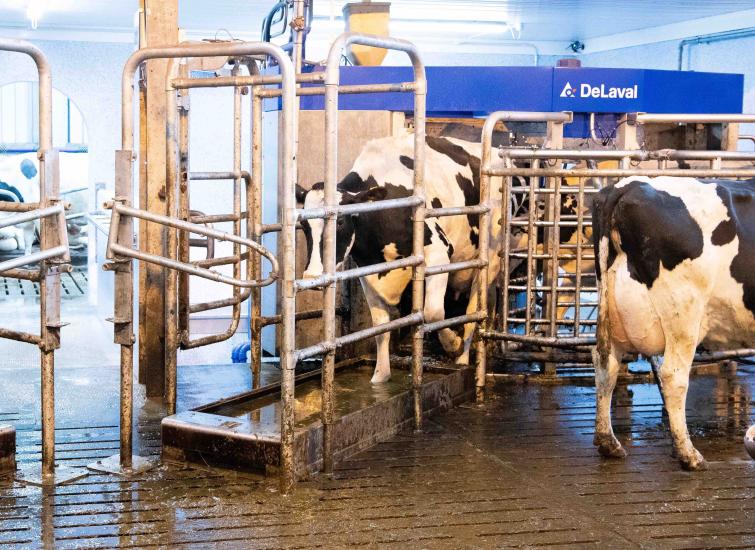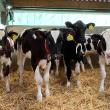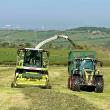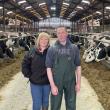Previous to Richard working with us we were struggling to get above 30/31 litres. Richard came in looked at the robot settings, the cow’s environment and nutrition. We saw an immediate response and an uplift in milk. We went from 31- 36 litres in very little time and it was down to Richard getting the diet right.
Careful Planning Needed to Set up Milking Robots
One Ayreshire family has managed a smooth transition to an automated milking system with careful planning and help from the farm's local robot supplier, vet and consultant Eoghan Mullery from Advanced Robot. British Dairying reports.

Keen to invest in the future of the dairy business, the Rennie family has planned carefully to introduce and manage an automated milking system - and to make it a success.
The Rennie family milks 220 Ayrshires and Holsteins at Brocklehill, Mossblown, just outside Ayr. The farm is a traditional, family run business with Keith and Irene Rennie and son Shaun, who is keen to continue their sucess and progress the business.
The first two DeLaval VMS V310 robots in the UK have been installed on the family's dairy unit, working with Eoghan Mullery at Advanced Robot, who helped with the preperation and set up the new system.
Advanced Robot is a specialist division of Advanced Nutrition. The robot team have a wealth of experience and proven results, supporting farms to set up and maximise robot milking across the UK. They are involved in both new build projects and more often, retro-fit into existing sheds, as they have done with the Rennies.
Milking options reviewed
“Our parlour was 18 years old, so we knew we were going to have to make an investment of some sort. We looked at different options but robots seemed the obvious choice for us. At that point we got Eoghan involved and found his advice invaluable,” explains Shaun Rennie.
Eoghan, who has worked with the Rennies since 2015, comments, “Rather than relying purely on the standard robot set up, the careful management of the cows, including their nutrition, environment, health, the team around them, as well as the management of the robot settings is the key to success.”
“In most circumstances, when we look at installing robots on a farm, the client’s goal is increased yield. The robots help achieve this, but other cow factors can’t be ignored. When cows are working harder to produce higher yields, areas such as cow comfort, feed and water space, airflow, are even more crucial to success. If we fail to provide the environment and management for higher yields - the benefit from robots can be short lived!”
“It was a pleasure to work with the Rennie family as they always have the full picture in mind. Changes were made to improve cow comfort; for example, the feed trough space was extended, extra water troughs were fitted, as well as fans for improved ventilation through the sheds.”
“We worked closely with the robot manufacturers pre and post installation, taking into consideration their requirements. The aim should be for the robots to improve the shed and we need to consider how they will affect the flow to maximise visits. Where the robots are positioned is crucial.”
“Nutrition is a key starting point and the foundation for success. Often, production gains can be made in relatively short periods of time through improved rumen health, which sets the cows up for further long-term success. However, it is worth noting that the nutrition at the point of set up and indeed often 3-6 months into the robots is not necessarily where the herd will be long term. The base diet and feed tables will evolve with the herd."
"I’ve been involved with many start-ups both in green field sites and retro fits and fortunately over the past 10 years have seen most situations! Each herd reacts differently when changing onto robots and while the technology is better now than 10 years ago, we still must study the herd week by week so that we can help ensure a smooth transition. This includes knowing where to set the base diet initially and when to start adjusting feed tables, milk permission settings etc. These all evolve specific to the herd and trying to follow a ‘set’ program rarely works! Our experience, and that of the farmer’s experience of their cows, help judge when to make each step.”
Eoghan stresses there is sometimes a misconception within the industry, that because robots promote a more natural flow and behaviour for the cows, there is less intervention needed from the farmer. Whilst this is true from a time saving point of view, if the system isn’t managed properly then farms will see milk yields and quality dropping. Every farm is different, so there isn’t one catch all solution.
Impact of health issues
However, what is true for every farm on an AMS, is when relying on cows to be voluntarily milked, health issues have a much greater impact on productivity.
Like conventional herds, robotic herds can still be affected by lameness, but again this is amplified. Eoghan explains, “The single biggest change for a cow moving onto robots is she’s no longer ‘herded’ into a parlour collect yard. To effectively milk ‘voluntarily’ she will need to be confident on her feet. If she’s not, she simply won’t put herself in an unfamiliar situation - meaning no visits and no milk!”
The Rennies have since increased the frequency of foot trimming and bathing. This was with the knowledge that going from parlour to voluntary milking meant they had to improve digital dermatitis levels which were manageable in the parlour but too high for robots.
With support from the supplier, Fullwoodhead Dairy Supplies, to incorporate footbaths on the robots to help manage the disease. They also purchased a robot scraper to keep floors clean.
Since installing the robots, a little more than six months ago, results have been good.
At the moment, 60 of the low yielders are still milked through the parlour twice per day, but the 126 highest yielders are now milking themselves three or more times daily on average through the robots. Average milk yields have increased from 31kg to 39kg and the Rennies are confident that yields will increase further.
More robots planned
“We wanted to get our high yielders on to the system first to see how they benefitted when just starting out with the two robots. But, we are looking at installing another two robots in the foreseeable future, when we’ll also increase herd numbers for a more viable enterprise,” explains Shaun.
“We are on a contract with Caledonian Cheese, so milk solids are important. We looked at breeding to improve milk quality as well as production, the cows are a little bigger than the more traditional cow in the herd, but for us it was more about producing an all-round more efficient cow to exploit the higher yields rather than the size.”
The goal wasn’t just about lifting production, although it certainly helped as a reward for all the long hours of planning and work! With the changes in the sheds, cow comfort has transformed the environment and the cows are now kept fuller, cleaner and more productive. Shaun adds, “Everything is to help with cow comfort because a happy cow is a profitable cow in our eyes and the cows have never looked better,” Shaun adds.
"At the start we realised that installing robots wasn't just down to the technology to make improvements. It was about looking at the whole management system. Advanced Robot helped us look at the bigger picture to maximise the potential of the AMS."
Scott Wilson from Fullwoodhead Dairy Supplies Ltd. comments, “The cows and family have taken so well to the new system, it’s a testament to all their hard work. Credit must also go to everyone else involved – it makes such a difference when we can work so well with customers, nutritionists and vets to help provide the best outcome for customer and cow. The information the Delpro Farm Management system provides for each cow allows for plenty of fine tuning, so it’s essential we work well together to ensure we get the best out of the system.”
Advanced Robot are realising the potential of robots up and down the UK. Indeed, Scotland is testament to that, with customers achieving well in excess of 40 litres/cow/day efficiently. With healthy cows proving they can maintain these types of yields, Eoghan believes the Rennies can be challenging these herds in the near future.
Published May 2021
〈 BACK




